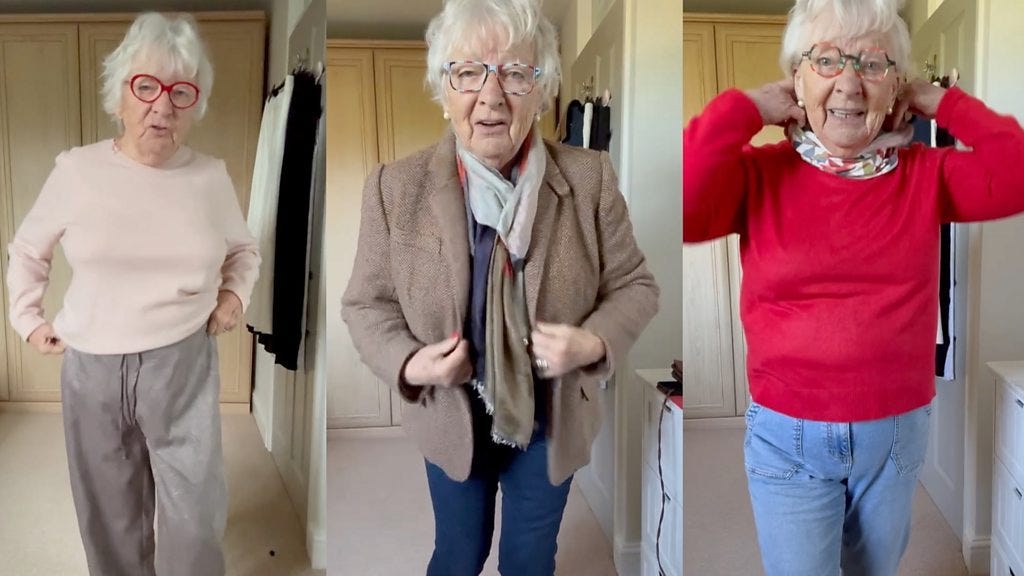Is the ‘Silver Influencer’ a New Freedom or an Age-Old Performance?
We’re witnessing something truly fascinating online: ‘silver influencers’ are taking over our feeds, seemingly breaking down ageist barriers. But as I delve into this phenomenon, I can’t help but wonder if this newfound visibility is genuine liberation or just another stage for us to perform, echoing the timeless questions Simone de Beauvoir posed about women and societal roles. Let’s explore this together.
Aging in the Public Eye: A Personal Dilemma
Have you noticed them? The vibrant, stylish women in their 60s, 70s, and beyond, gracing your TikTok and Instagram feeds? They are the ‘silver influencers,’ and their rise is undeniable. On the surface, it feels like a breath of fresh air, a defiant rejection of a society that often pushes older women into the shadows. I’ve often felt the subtle societal pressure to remain ‘youthful,’ a pressure that seems to intensify with each passing year. So, when I see these women confidently flaunting their style and wisdom, a part of me cheers.
But then, a quieter, more reflective voice whispers: is this truly liberation, or are we simply exchanging one set of expectations for another? Are we genuinely celebrating the rich tapestry of aging, or are we, perhaps unconsciously, still striving for an ‘ageless’ ideal, packaged for digital consumption? It’s a question that feels both timely and deeply personal, resonating with the very human weakness of wanting to be seen and valued.
The Lure of the Ageless Icon: What We See and What We Want
The appeal of silver influencers is clear. They present a powerful alternative to the youth-centric narratives that dominate media. They show us that aging doesn’t have to mean becoming invisible or irrelevant. They offer fashion tips, life advice, and a general air of ‘joie de vivre’ that is incredibly aspirational. For many, especially younger generations, they represent a hopeful vision of what growing older can look like, bridging what can often feel like an insurmountable generational divide.
The platforms themselves are key here. Social media, for all its flaws, allows for a direct connection, a more ‘authentic’ (or at least, performatively authentic) window into lives that might otherwise remain unseen. This democratizing effect means that influence isn’t just for the traditionally beautiful or the exceptionally young anymore. It’s a space where experience and personality can truly shine, attracting diverse audiences who are hungry for more than just the superficial. It’s a recognition of a truth many of us instinctively feel: that wisdom and style don’t have an expiration date.
When Liberation Becomes a New Expectation: The Hidden Pressures
This is where the dialectic gets interesting, and frankly, a bit unsettling. While these influencers certainly challenge the status quo, we must ask if this newfound visibility comes with its own set of chains. Simone de Beauvoir, in her seminal work “The Second Sex,” eloquently explored how societal structures define and often limit women at every stage of life. She might have looked at our digital age and seen a new stage for the same old play.
One is not born, but rather becomes, a woman.
– Simone de Beauvoir,
The Ethics of Influence: Navigating Authenticity in a Curated World
To truly harness the emancipatory potential of the ‘silver influencer’ phenomenon, we must engage in a synthesis that moves beyond both naive celebration and cynical dismissal. The core challenge is to differentiate between genuine self-expression and the insidious demands of a performance economy. For individuals, this means cultivating a critical awareness of the platforms they engage with, asking whether their online presence truly reflects their inner self or if it merely conforms to algorithmic pressures.
Culturally, we must elevate wisdom and lived experience over fleeting digital aesthetics. This involves actively supporting narratives that celebrate the full spectrum of aging, including its vulnerabilities and quiet dignities, rather than solely promoting an ‘ageless’ ideal. The goal is not to eradicate the visibility of older individuals, but to ensure that this visibility serves authentic selfhood rather than becoming another cage of expectation. Only by embracing a nuanced understanding of these digital shifts can we empower generations to come to navigate aging with integrity, fostering a truly inclusive and resonant public sphere that values depth over superficial performance.
Go Deeper
Step beyond the surface. Unlock The Third Citizen’s full library of deep guides and frameworks — now with 10% off the annual plan for new members.
Reclaiming Authenticity: Navigating the Performance of Aging Online
To truly harness the emancipatory potential of the ‘silver influencer’ phenomenon, society must engage in a synthesis that moves beyond both naive celebration and cynical dismissal. The core challenge is to differentiate between genuine self-expression and the insidious demands of a performance economy. For individuals, this means cultivating a critical awareness of the platforms they engage with, asking whether their online presence truly reflects their inner self or if it merely conforms to algorithmic pressures.
Culturally, we must elevate wisdom and lived experience over fleeting digital aesthetics. This involves actively supporting narratives that celebrate the full spectrum of aging, including its vulnerabilities and quiet dignities, rather than solely promoting an ‘ageless’ ideal. The goal is not to eradicate the visibility of older individuals, but to ensure that this visibility serves authentic selfhood rather than becoming another cage of expectation. Only by embracing a nuanced understanding of these digital shifts can we empower generations to come to navigate aging with integrity, fostering a truly inclusive and resonant public sphere that values depth over superficial performance.



